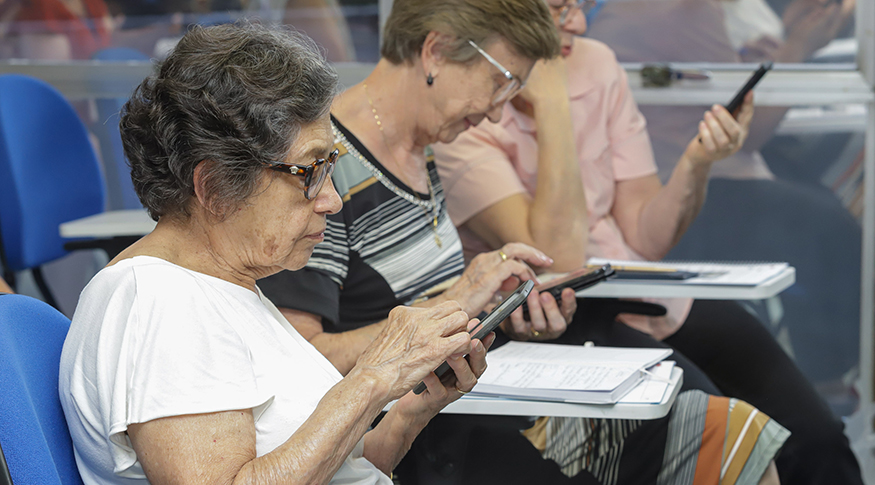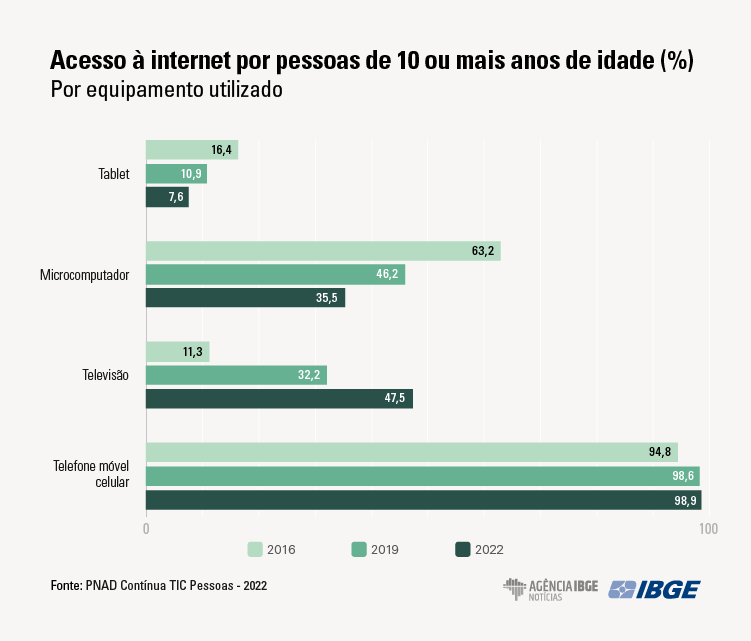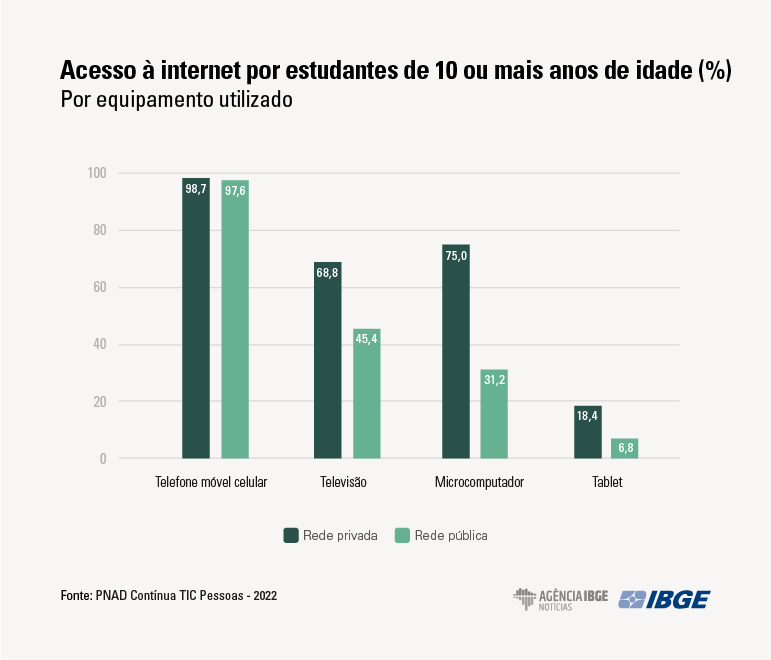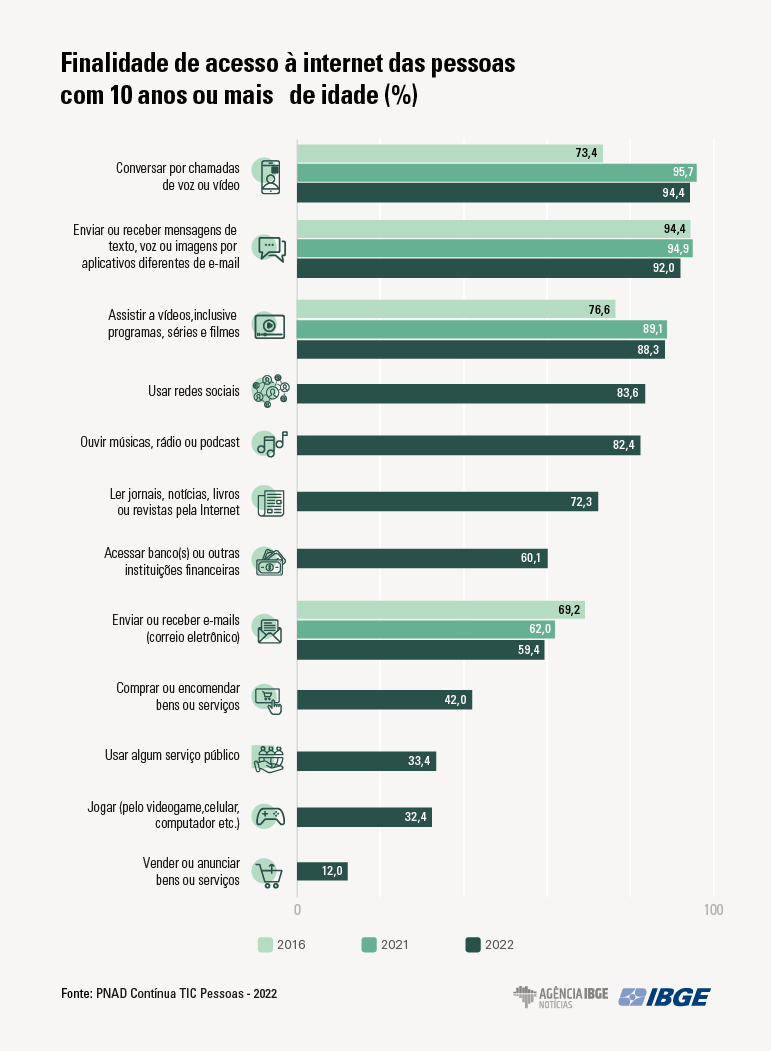Continuous PNAD
161.6 miillion persons aged 10 and over used the Internet in Brazil in 2020
November 09, 2023 10h00 AM | Last Updated: November 16, 2023 04h21 PM
Highlights
- The proportion of persons aged 10 and over who used the Internet in the country increased from 84.7% in 2021 to 87.2% in 2022.
- The percentage of elderly persons (60 years and older) using the Internet rose from 24.7% in 2016 to 62.1% in 2022.
- 98.4% of private school students and 89.4% of public school students used the Internet in 2022.
- The most used equipment to access the Internet in 2021 was the cell phone (98.9%). Next, still with a considerable difference, came TV (47.5%).
- The proportion of people who accessed the internet via personal computers fell from 63.2% in 2016 to 35.5% in 2022. Access to the Internet via tablets also fell, in this period, from 16.4% to 7.6%.
- Continuous PNAD investigated, for the first time in 2022, the frequency with which people used the Internet: 93.4% used it every day.
- 94.4% of users accessed the Internet to chat via voice or video calls. The other most reported purposes were: sending or receiving text, voice or image messages via applications other than email (92.0%); watching videos, including shows, series and films (88.3%) and using social media (83.6%).
- In 2022, 8.9% of users accessed the Internet via a free public connection in schools, universities or public libraries. Among public school students using the Internet, 26.7% used this form of access.
- The majority of people who did not use the Internet in 2022 were among the less educated or elderly (60 years of age or older). The predominant reason for not accessing the internet was not knowing how to use it (47.7%). For 66.1% of the elderly who did not use the Internet, this was the main reason.
- In 2022, 86.5% of persons aged 10 or over had a cell phone for personal use, which represents an increase of 2.1 percentage points compared to 2021 (84.4%).
 The number of elderly persons who used the Internet has grown significantly since 2016 - Photo: Roberto Dziura Jr AEN-Pr
The number of elderly persons who used the Internet has grown significantly since 2016 - Photo: Roberto Dziura Jr AEN-PrIn 2022, among the 185.4 million persons aged 10 or over in the country, 87.2% (or 161.6 million) used the Internet in the reference period (last three months prior to the interview), compared to 84.7% in 2021. This is what the Information and Communication Technology (ICT) module of the Continuous National Household Sample Survey (PNAD), released today by the IBGE, shows.
In rural areas, the percentage was lower, but it has been growing: it started at 33.9% in 2016, in the first edition of the survey, increased to 67.5% in 2021 and reached 72.7% in 2022. "The proportion of the number of people using the internet has increased since the beginning of the survey, even in rural areas. However, there is still a big difference compared to urban areas, although this difference has been reducing over time", highlights survey analyst Gustavo Geaquinto.
The Major Region with the highest percentage of internet users is still the Central-West, influenced by the Federal District, which has the highest proportion (96.6%) of users among the 27 Federation Units. The North (82.4%) and Northeast (83.2%) Regions remained with the lowest results, even presenting the largest expansions between 2021 and 2022: 6.1 percentage points (pp) and 5.1 pp, respectively.
Among uneducated persons, 39.4% accessed the Internet, a percentage much lower than that of other educational groups, such as persons with incomplete higher education (98.7%) and those with a higherdegree (98.2%).
Percentage of elderly persons who used the Internet keeps growing and reaches 62.1%
Children and elderly persons are the age groups with the lowest percentage of Internet users in 2022. The age group of 10 to 13 recorded 84.9%, and this percentage grew gradually to reach the peak of more than 96% of users in the groups of persons aged 20 to 24 and 25 to 29 years old. From there on, the proportion of internet users falls in the following age groups, achieving 62.1% among persons aged 60 and over.
Although Internet use has grown in all age groups, the pace was more accelerated among the elderly aged 60 and over. In 2026, the proportion of the elderly using the Internet was 24.7, having risen to 62.1% in 2022. “This increase might have been caused by the growing user-friendly technology and its dissemination in society’s routine. “It is a group which has advanced a lot in the use of technology”, says Mr, Geaquinto.
The greatest percentage of elderly Internet users was in the Central -West (69.4%) and the lowest in the Northeast (51.3%). Among the Fus, the Federal District leads(82.2%), followed by Rio de Janeiro (72.3%), Roraima (71.6%) and São Paulo (70.6%). At the bottom of the list are Paraíba (48.7%), Maranhão (46.4%) and Piauí (45.9%).
Students used more the Internet, but with differences between private and public education
In 2022, 92.2% of the students reported having used the Internet, while non-students amounted to 85.9%, a rise in both groups when compared to 2021. “When considering the educational system, there are important differences in the Internet use concerning students”, indicates Geaquinto. Whereas 98.4% of the private system students used the Internet in 2022, this percentage among the public system students was 89.4%.
The North Region (84.0%) was the area where the percentage of Internet users among students stood below 90%. The greatest percentages were seen in the Southeast (94.7%) and in the Central-West (94.5%). Regionally, there were differences among private and public education. In the North and Northeast, the percentages of public students who used the Internet were 80.1% and 87.7%, respectively, while in the other regions, this percentage ranged between 91.6% and 92.4%. However, when only private school students are considered this percentage stands above 97% in all Major Regions.
TV use grows, while tablet and computer use drops

The most reported means of Internet access was mobile cell phones (98.9%). Next, but with a significant difference, comes television. Since the beginning of the ICT module of the Continuous PNAD, the number of Internet users through TVs has been growing fast. It left the 11.3% figure in 2-16 to reach 32.2% in 2019, achieving 47.5% in 2022. Personal computers, in turn, goes the other way around: in 2016, they reached 63.2%, reaching 46.2% in 2019 to achieve 35.5% in 2022. Tablets have been falling too: from 16.4% in 2016 to 7.6% in 2022.
Considering the student status, the survey shows some differences, although, among students, there is still a greater use of TVs (53.2%), they also record a higher use of personal computers (45.8%) and tablets (10.7%), when compared to non-students. “However, even among students, the use of PCs and tablets to access the Internet has been droping throughout the years”, highlights the survey analyst.
Once again there are significant differences in the use of devices between students of the public educational system and that of the private one. Whereas 75% of the private system students accessed the Internet though PCs, among public students, the figure was just 31.2%.
The use of TVs for accessing the Internet occurred for 68.8% of the private system students, one and a half times more that the percentage of the public system students (45.4%). Concerning tablets, the difference was three times bigger: 18,4% in the private system and 6.8% in the public system.

In 2022, 94.4% used the Internet for voice or video calls
The Continuous PNAD investigated, for the first time in 2022, the frequency with which people normally used the Internet. Among those who used it, 93.4% used it regularly every day; 2.7% used it almost every day (five or six days a week); 3.2% one to four times a week; and only 0.7% used it less frequently than once a week. Among the Major Regions, the lowest daily use rate was for the North (89.2%) and the highest for the Central-West (95.0%).

Also for this edition, the Continous PNAD expanded the investigation into the purpose of accessing the Internet, adding new items to be answered, such as using social media, listening to music, radio or podcasts and reading newspapers, news, books or magazines, among others.
Internet access for voice or video calls was the most reported purpose, reaching 94.4% of users, a drop of 1.3 pp compared to 2021. Next was sending or receiving text messages, voice or images via applications other than email, with 92.0%, a drop of 2.9 pp compared to 2021.
Other purposes of use mentioned by the majority of users: watching videos, including shows, series and films (88.3%); social media (83.6%); listening to music, radio or podcasts (82.4%); reading online newspapers, news, books or magazines (72.3%); accessing banks or other financial institutions (60.1%); and sending or receiving emails (59.4%). Among the highlights, the answer “play” appeared for 32.4% of persons, with a marked difference between men (39.0%) and women (26.3%).
Among students, the main differences referred to the use of the Internet to play games, much higher among those who study (60.2%), and accessing banks or other financial institutions, considerably lower (40.6%). “Such differences can be explained by the age profile of these groups, since students are, on average, younger, and therefore, have more specific Internet usage habits”, explains Mr. Geaquinto.
8.9% of users accessed the Internet for free in public educational institutions
Also for the first time, this PNAD module investigated free Internet access (Wi-Fi) in some public places. Among the places investigated, 8.9% of those who used the Internet said they had accessed the service for free in schools, universities or public libraries; 5.2%, in public health establishments, such as health centers and public hospitals; and 5.5%, in public squares or parks.
Regionally, for the three types of public places surveyed, the highlight was the South Region, which had the highest percentages of free Internet access: 11.7%, 7.9% and 8.1%, respectively.
In the country, among public school students who used the Internet in the reference period, 26.7% accessed the service free of charge in schools, universities or public libraries, with the South Region also presenting the highest percentage (35.5%).
Elderly persons and less educated ones are the majority among those who did not use the Internet
Of the 185.4 million persons aged 10 or over, 12.8% said they had not used the Internet in the reference period. The majority of this group was made up of uneducated people or those with incomplete primary education (78.5%) and aged 60 or over (52.3%).
Among the reasons, not knowing how to use the Internet (47.7%) and lack of need (23.5%) appeared with the highest percentage. The next reasons were economic reasons (Internet access service was expensive and the necessary electronic equipment was expensive) which, together, amounted to 16.2%.
The percentage of persons not using the Internet due to the service not being available was higher in the North Region (9.7%) and in rural areas (8.0%) than the national average (3.6%).
More about the survey
The Information and Communication Technology (ICT) module of the Continuous National Household Sample Survey - Continuous PNAD has analyzed, since 2016, access to the Internet and television and ownership of cell phones for personal use, with geographic detail for Brazil, Major Regions and Federation Units. For more information, please, access the support material and the full publication.




















